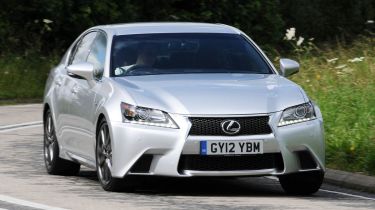Lexus GS 250 F Sport
The Lexus GS 250 is the entry-level version of the BMW 5 Series rival. We drive it in striking F Sport trim

Lexus has taken a step forward with the latest GS and there’s no denying the GS 250 F Sport’s showroom appeal. It looks the part thanks to its racy body kit and is better to drive than its predecessor. It’s also generously equipped. However, it’s still too dull to drive. Until a cheaper low emission hybrid version turns up, it will remain a niche choice.
The Lexus GS 250 F Sport has the style of a high performance saloon, but without the price tag. Its 206bhp 2.5-litre V6 petrol engine marks the entry point to the GS line-up, and with a price tag of £39,995, it’s some £11,000 less than the range-topping GS 450h F Sport.
All F Sport models get the same racy front splitter, low side sills and a rear boot spoiler, with 19-inch alloys and special F Sport badging. Inside are 16-way adjustable seats, plus a sports steering wheel and gearknob.
There’s no rear wheel steer or variable ratio steering rack from the GS 450h F Sport, but it does come with Adaptive Suspension, which makes the GS 250 a bit more responsive when you’re in the mood.
Select Sport+ and the steering and suspension are sharpened up making the GS feel quite agile. It turns into corners quickly and has decent grip. The V6 engine feels responsive and makes an enjoyable growl too, while 0-62mph takes just 8.6 seconds.
Sadly, it’s not all good news. The ride on those large alloys can be quite choppym while the GS wallows around in its softer driving modes. A £38,440 BMW 528i M Sport is much faster – 0-62mph takes just 6.3 seconds – and more enjoyable to drive.
The BMW is also more responsive thanks to its eight-speed automatic, whereas the Lexus gets a terrible droning six-speed CVT gearbox. It’s okay when using a light throttle at a cruise but otherwise falls way behind the class leaders.
The GS 250 F Sport isn’t very efficient either. Lexus claims 31.7mpg and 207g/km of CO2, while the 245bhp 2.0-litre turbocharged 528i M Sport posts 41.5mpg and 158g/km.
Where the GS does win is with standard equipment. The generous list includes a vast central display, 12-speaker stereo, front and rear parking sensors, leather upholstery and LED daytime running lights.
The problem is it might look good, but it’s not efficient enough to appeal to company car drivers or daringly different enough to attract new private buyers to the brand.







